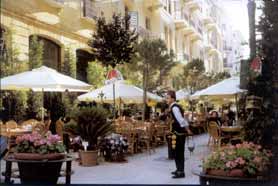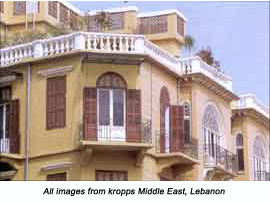|
Lebanon
is indeed a small country, slightly more
than ten thousand square kilometres in
area. But very few countries in the world,
if any, could claim so much charm packed
in such an area. The Lebanese call their
country: God’s Paradise on Earth.
Probably they have every right; for they
have unsurpassed natural beauty, more than
fingerprints of countless civilizations
over many millenniums, world famous
traditions, all coupled with a very
hospitable, fun-loving people.
Its
coastline of 225 km along the Eastern
Mediterranean runs parallel to a double
ridge of mountains: the evergreen western
Mount Lebanon reaching over 3000 meters
and the arid Anti-Lebanon on the east. In
between the two ridges lies the fertile
Beqaa valley, which, in many ways, is
distinct from the coastal region. Lebanon
has as well three different climates,
despite its small size: rainy cold winters
and hot humid summers along the coast,
snowy winter and springs, and cool summer
in the Alpine Mountains in the middle, and
the Beqaa valley with its dry & hot
summers, dry and frosty winters.
In
fact, every village, town and city in
Lebanon has its own attractions, history,
traditional handicraft, and nightlife. A
visit to Lebanon will not be complete
without touring the beautiful resorts of
Al Matn, or tasting the famous tabbouli or
Kebbeh of Zahleh, or watching some of
Lebanon famous singers and dancers
performing in tens of nightclubs that
cater to every taste. Some of the most
popular places in Lebanon are:
 Beirut,
the Capital, once known as the “Paris of
the East”, lies along a magnificent
portion of the coast, with towering
mountains behind it, visible when the
traffic haze settles down. The Corniche
seafront boasts beaches, restaurants,
theatres and a dazzling variety of shops
and restaurants. Beirut has suffered
greatly from Lebanon's 16-year civil war,
but following an impressive and ongoing
process of reconstruction, the city is
once again one of the most popular tourist
and business destinations in the Middle
East. Beirut,
the Capital, once known as the “Paris of
the East”, lies along a magnificent
portion of the coast, with towering
mountains behind it, visible when the
traffic haze settles down. The Corniche
seafront boasts beaches, restaurants,
theatres and a dazzling variety of shops
and restaurants. Beirut has suffered
greatly from Lebanon's 16-year civil war,
but following an impressive and ongoing
process of reconstruction, the city is
once again one of the most popular tourist
and business destinations in the Middle
East.
While
many of the new buildings look very
modern, Beirut's old souks are being
reconstructed in an authentic way.
Lebanon's only museum, the Beirut National
Museum, has been rehabilitated and is
constantly updating its interesting
collection. On the western tip of Beirut,
Raouche is an increasingly popular
district with a lively seaside promenade.
Its famous landmark, the Pigeon Rocks, are
huge formations standing like sentinels
off the coast. 20km (13 miles) north of
Beirut, the spectacular Jeita caverns are
a popular tourist attraction. The caverns
are on two levels, and the lower gallery
includes an underground waterway, which
can be visited by boat (but may be
closed during winter).
Tripoli,
the country's second city, dates back to
the 8th century BC and the town centre,
though surrounded by modern housing
developments and beach resorts, has
preserved its character. There are two
parts – the port area and the city
proper – that are divided by acres of
fragrant orange plantations. Tripoli's old
medieval centre at the foot of the
Crusader castle has a number of
interesting mosques.
Baalbeck,
Lebanon's greatest Roman treasure, can be
counted among the wonders of the ancient
world The largest and most noble Roman
temples ever built, they are also among
the best preserved Towering high above the
Beqaa plain, their monumental proportions
proclaimed the power and wealth of
Imperial Rome> The gods worshipped
here, the Triad of Jupiter, Venus and
Mercury, were grafted onto the indigenous
deities of Hadad, Atargatis and a young
male god of fertility. Local influences
are also seen in the planning and layout
of the temples, which vary from the
classic Roman design.
Over
the centuries Baalbeck's monuments
suffered from theft, war and earthquakes,
as well as from numerous medieval
additions. Fortunately, the modern visitor
can see the site in something close to its
original
form thanks to work in the past hundred
years by many archaeologists.
Baalbeck
is located on two main historic trade
routes, one between the Mediterranean
coast and the Syrian interior and the
other between northern Syria and northern
Palestine. Today the city, 85 kilometres
from Beirut, is an important
administrative and economic centre in the
Beqaa valley.
During
the Hellenistic period the Greeks
identified the god of Baalbeck with the
sun god and the city was called Heliopolis
or City of the Sun. At this time the
ancient enclosed court was enlarged and a
podium was erected on its western side to
support a temple of classical form.
Although the temple was never built, some
huge structures from this Hellenistic
project can still be seen. And it was over
the ancient court that the Romans placed
the present Great Court of the Temple of
Jupiter.
 Tyre
was founded at the start of the 3rd
millennium BC and, today, still bears
impressive traces of its ancient origins.
Tyre's archaeological sites are divided
into three areas: area one is located on
what was the Phoenician island and
contains ruins of the large district of
civic buildings, public baths and mosaic
streets; area two contains an extensive
network of Romano-Byzantine roads and
other installations; area three is most
notable for containing one of the largest
Roman hippodromes ever found. Tyre
was founded at the start of the 3rd
millennium BC and, today, still bears
impressive traces of its ancient origins.
Tyre's archaeological sites are divided
into three areas: area one is located on
what was the Phoenician island and
contains ruins of the large district of
civic buildings, public baths and mosaic
streets; area two contains an extensive
network of Romano-Byzantine roads and
other installations; area three is most
notable for containing one of the largest
Roman hippodromes ever found.
Byblos
is reputed to be the oldest town in the
world, with excavations unearthing
artefacts dating back to Neolithic times
as well as from Canaanite, Phoenician,
Hellenistic, Roman and Crusader periods.
Fishing boats and pleasure craft ply the
old harbour. Even
the Phoenicians considered it a city of
great antiquity. Although its beginnings
are lost in time, modern scholars say the
site of Byblos goes back at least 7,000
years
Today
Byblos (Jbeil in Arabic) on the coast 70
kilometres north of Beirut, is a
prosperous place with glass-fronted office
buildings and crowded streets. But within
the old town, medieval Arab and Crusader
remains
are
continuous reminders of the past.
Nearby are the extensive excavations that
make Byblos one of the most important
archaeological sites in the area.
Beiteddine,
in the Chouf Mountains, is the site of the
palace built by the Amir Basheer in the
19th century. The courtyard and staterooms
are well worth a visit.
Besharre,
in the north, is simply
known as the "The Cedars,"
this resort settlement in Lebanon's
highest range is one of the most
dramatically beautiful spots in the
country. Its centrepiece is an ancient
grove of cedars, a tree synonymous for
millennia with Lebanon itself. Just below
the Cedars is the town of Bsharre,
birthplace of the
famous Lebanese poet Gibran
Khalil Gibran, author
of The Prophet.
At
the crest you look down the other side
into a gigantic bowl where the ski resort,
the cedar grove and the Qadisha gorge lie
before you in a wide-angle panorama.
In
addition, there are some more gentle
cedars near Tannourine.
In Jaj near
Laqlouq isolated specimens of cedars are
still scattered on the rocky peaks above
the town. Deep in the Shouf district on
top of Mount Barouk, cedars some 350 years
old grow in an enclosed grove. These
trees, which are in pristine condition,
can be easily admired from outside the
protective wall. Above the town of Maaser
esh-Shouf, there is another cedar forest,
which has an extended view of the Beqaa
valley. Cedar trees also grow in nearby
Ain Zhalta.
Lebanese cuisine is
widely acknowledged to be the finest in
the Middle East. Excellent Lebanese food
is available everywhere. A dish unique to
Lebanon is kebbeh, made of very finely
minced mutton, with burghul or cracked
wheat, and served raw or baked in flat
trays or rolled into balls and fried. Also
recommended is the traditional Lebanese
mezza, a range of up to 40 small dishes
served as appetizers. Lebanon is also
famous for its fresh fruit, including
melon, apples, oranges, persimmon,
tangerines, cactus fruit, grapes and figs.
There are also large choices of
international restaurants, which offer
dishes from all over the world.
Nightclubs
spice up the evenings in Beirut and
mountain resorts. Entertainment ranges
from solo guitarists to orchestras and
floorshows. Some British-style pubs can be
found in Beirut. There are many cinemas
presenting the latest films from all over
the world. After extensive refurbishment,
the internationally renowned Casino du
Liban in Maameltain (22km/14 miles north
of Beirut) was reopened in 1997.
|
